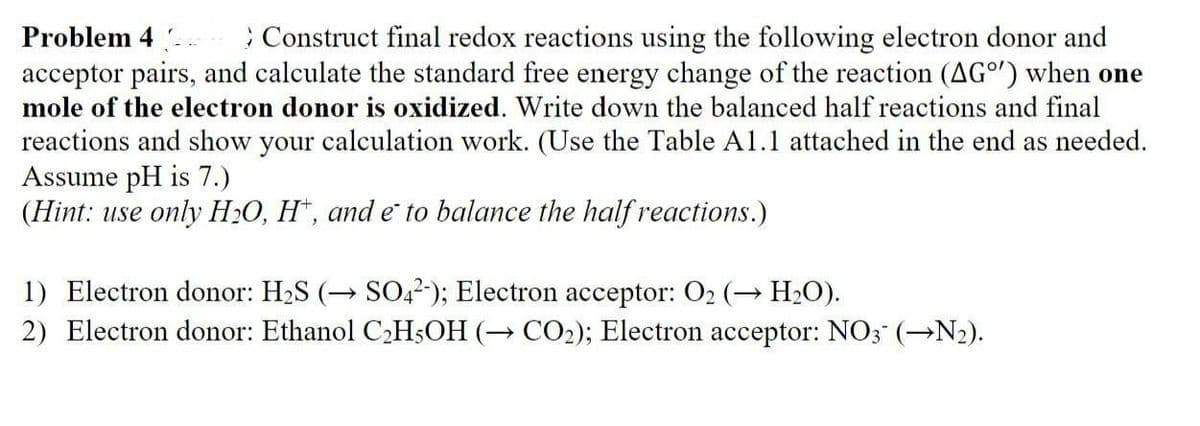Problem 4 Construct final redox reactions using the following electron donor and acceptor pairs, and calculate the standard free energy change of the reaction (AG°') when one mole of the electron donor is oxidized. Write down the balanced half reactions and final reactions and show your calculation work. (Use the Table A1.1 attached in the end as needed. Assume pH is 7.) (Hint: use only H₂O, H, and e' to balance the half reactions.) 1) Electron donor: H₂S (→ SO42-); Electron acceptor: O₂ (→ H₂O). 2) Electron donor: Ethanol C₂H5OH (→ CO₂); Electron acceptor: NO3- (→N2).
Problem 4 Construct final redox reactions using the following electron donor and acceptor pairs, and calculate the standard free energy change of the reaction (AG°') when one mole of the electron donor is oxidized. Write down the balanced half reactions and final reactions and show your calculation work. (Use the Table A1.1 attached in the end as needed. Assume pH is 7.) (Hint: use only H₂O, H, and e' to balance the half reactions.) 1) Electron donor: H₂S (→ SO42-); Electron acceptor: O₂ (→ H₂O). 2) Electron donor: Ethanol C₂H5OH (→ CO₂); Electron acceptor: NO3- (→N2).
Chemistry
10th Edition
ISBN:9781305957404
Author:Steven S. Zumdahl, Susan A. Zumdahl, Donald J. DeCoste
Publisher:Steven S. Zumdahl, Susan A. Zumdahl, Donald J. DeCoste
Chapter1: Chemical Foundations
Section: Chapter Questions
Problem 1RQ: Define and explain the differences between the following terms. a. law and theory b. theory and...
Related questions
Question

Transcribed Image Text:Problem 4
Construct final redox reactions using the following electron donor and
acceptor pairs, and calculate the standard free energy change of the reaction (AG°') when one
mole of the electron donor is oxidized. Write down the balanced half reactions and final
reactions and show your calculation work. (Use the Table A1.1 attached in the end as needed.
Assume pH is 7.)
(Hint: use only H₂O, H, and e to balance the half reactions.)
1) Electron donor: H₂S (→ SO42-); Electron acceptor: O₂ (→ H₂O).
2) Electron donor: Ethanol C₂H5OH (→ CO₂); Electron acceptor: NO3- (→N₂).
Expert Solution
This question has been solved!
Explore an expertly crafted, step-by-step solution for a thorough understanding of key concepts.
Step by step
Solved in 4 steps with 3 images

Knowledge Booster
Learn more about
Need a deep-dive on the concept behind this application? Look no further. Learn more about this topic, chemistry and related others by exploring similar questions and additional content below.Recommended textbooks for you

Chemistry
Chemistry
ISBN:
9781305957404
Author:
Steven S. Zumdahl, Susan A. Zumdahl, Donald J. DeCoste
Publisher:
Cengage Learning

Chemistry
Chemistry
ISBN:
9781259911156
Author:
Raymond Chang Dr., Jason Overby Professor
Publisher:
McGraw-Hill Education

Principles of Instrumental Analysis
Chemistry
ISBN:
9781305577213
Author:
Douglas A. Skoog, F. James Holler, Stanley R. Crouch
Publisher:
Cengage Learning

Chemistry
Chemistry
ISBN:
9781305957404
Author:
Steven S. Zumdahl, Susan A. Zumdahl, Donald J. DeCoste
Publisher:
Cengage Learning

Chemistry
Chemistry
ISBN:
9781259911156
Author:
Raymond Chang Dr., Jason Overby Professor
Publisher:
McGraw-Hill Education

Principles of Instrumental Analysis
Chemistry
ISBN:
9781305577213
Author:
Douglas A. Skoog, F. James Holler, Stanley R. Crouch
Publisher:
Cengage Learning

Organic Chemistry
Chemistry
ISBN:
9780078021558
Author:
Janice Gorzynski Smith Dr.
Publisher:
McGraw-Hill Education

Chemistry: Principles and Reactions
Chemistry
ISBN:
9781305079373
Author:
William L. Masterton, Cecile N. Hurley
Publisher:
Cengage Learning

Elementary Principles of Chemical Processes, Bind…
Chemistry
ISBN:
9781118431221
Author:
Richard M. Felder, Ronald W. Rousseau, Lisa G. Bullard
Publisher:
WILEY